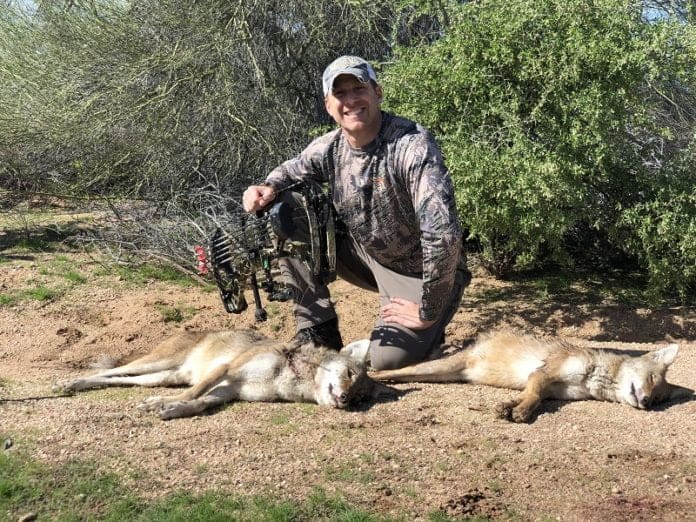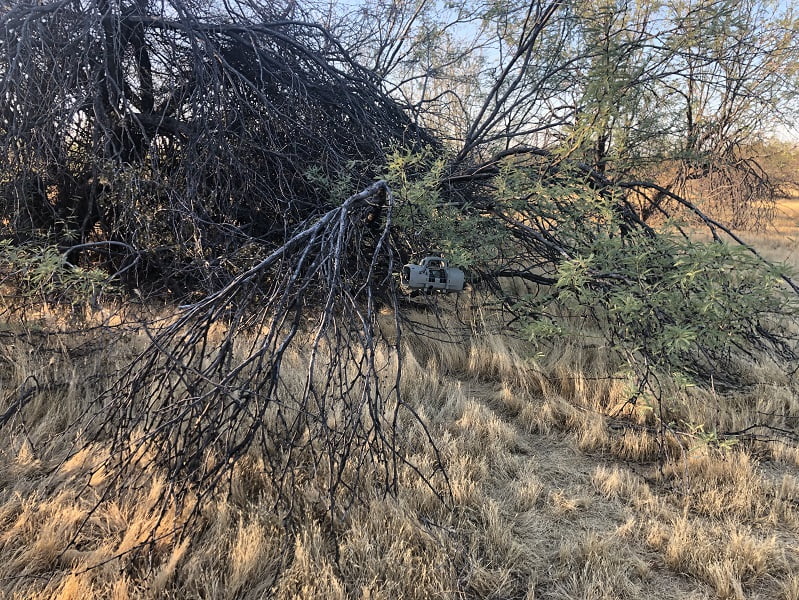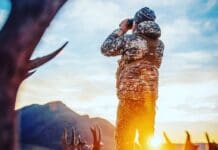
Whether you’re a beginner or a seasoned predator hunter, it’s tough to get a coyote (or any predator) with a bow… They come in hot, they come in super alert, and they can jump a string faster than any deer I have every shot at…… So I have developed a couple of little tricks over the years to get predators within bow range and actually get off a shot. Read on my friend and you too may put an arrow in one of the West’s most difficult bowhunting quarry.
Unlike firearm hunting where the setup is not as important as location, with archery equipment, how you set up the stand will make the difference between getting a coyote or watching him run away, leaving you wishing for your shotgun.
I mentioned location and I am going to quickly touch on this before we get to the set up part. Obviously if you’re not calling where coyotes and other predators “hang”…. then the best set up in the world isn’t going to help you. Doing your homework finding travel corridors, bedding areas and “hunting grounds” are key to having a response to your call..
I put hunting grounds in quotes above because I am referring to where predators hunt. I often try to put myself in the mindset of the predator. Where would I go to hunt rabbits, mice, etc.? How would I sneak up on these animals? How would I enter and exit these areas undetected? I employ this method of thinking to narrow down my starting points for scouting, or simply as a substation for scouting when hunting in new areas.
Ok back to the lecture at hand. The set up or “stand” is made up of three parts:
- The Hide
- The Blind
- The Room
The hide is where you hide the e-call this should be within half the distance of your effective range, so if you feel comfortable shooting and guessing range out to 60 yards, your hide should not be more than 30 yards from you. Another important thing to remember is to find a Hide that fits the sound you are trying to conceal. For instance, a large bush can hide a screaming rabbit but its not going to cut it for a fawn in distress; you need a bigger structure for a bigger animal. It should be positioned so that you are not obvious when the predator comes to the call, and so that he will be focused on The Hide.
The Blind is where you set up to shoot from.
The Room is the area you have chosen to call in and it should be no larger than your effective range. To get a complete understanding of this, check out the first article in this series here. These three make the parts of a set-up.
Now finding a good set up to score a coyote with a bow is made of up of four different key components:
- Approach
- Wind Direction
- Vantage Point
- Concealment
Approach
When at all possible, I like to enter an area in an ”L” shaped approach walking in with the wind in my face then taking a hard 90-degree turn so that the wind ends up being side-to-side instead of in my face… Why? Because more times than not a predator (especially cats) will approach from downwind which means they will come from behind you if the wind is in your face.
I also take this “L” to minimize the amount of scent I am leaving behind me. To this note, when possible I enter from the direction that my wind is being carried away from the direction I believe they will come from. I also try to approach my stand by avoiding disturbing the area by making as little noise as possible; no skylining myself and without leaving my truck in plain sight. If I don’t have these options, I don’t bow hunt that spot, period. Predators are not stupid. In fact, it’s my experience that they have the capability to think more critically than prey animals such as deer and elk. You often hear of guys talking about educating coyotes. That’s because they don’t typically make the same mistake twice and are very weary of things that don’t feel right. So do your best not to tip them off that you are in the area.
Wind Direction
We already talked about the wind a bit but to get a bit more detailed, I prefer the wind be in the 5-15 mph range. This helps with concealing your movement when you draw.. When the bushes and vegetation around you are moving with the wind, they are less likely to catch you moving. When at all possible I like the wind going from the area I think is holding the coyotes away and across me because putting the wind side-to-side often will make them cross in front of you broadside. However, if the wind is going toward them from your call, not your hide position, it’s OK; I just make sure I lay a little scent down (rabbit distress or fox urine) to add to the illusion.
Speaking of illusion, decoys or motion decoys are a good tool for this set up, but for the most part I don’t use them. I find that if I hide my call in a large structure like a bush, deadfall, or tree–something they have to physically look inside of to determine what’s making the noise–it actually gets them to stop longer and exactly where I want them to.
Vantage Point
The terrain doesn’t always lend itself to this but I like to have a bit of a vantage point even if it’s just a little rise or a rock out cropping. I really try to pick spots that have the terrain sloping away from me even if it’s a slight slope. But when I can’t I look for small open parks just big enough to shoot across (50 yards or less) or I look for edge cover–basically something that gives me the advantage of seeing them before they see me. If you can couple this with good concealment, you will improve your odds of getting a shot off.
Concealment
Aside from having good camo and controlling your scent, your vantage point should be a counterpart to your concealment. In fact, it’s probably the most important piece to the puzzle.. I try to look for a tree or shrubbery that I can sit down under or against or even better, in. I want to clear it all, remove anything that may give me away or make noise. Also, I check my draw and make sure I have clearance and the ability to shoot at all my open points or lanes. I usually like to have some kind of brush or deadfall in front of me, just enough to help break me up, but not take away from my ability to shoot. Shade is a great tool for concealment as well, especially if the shade is just covering you and creates an edge just beyond your position.. The sun is your friend if you can keep it behind you. Nothing works better to get a dog to stop and stare for that extra moment than having the sun at your back and in his eyes. The contrary to this, is having the sun in your face. I avoid this set up at all cost as I’m lit up like a Christmas tree. This is true even if I have a bit of top shade.
Other points of concealment such as a buffer bush or a boulder that allows you to see through or around, but is big enough for you to come to full draw without him seeing you as hit hits your shooting lane.
Bonus info
Well now all you gotta do is sweet talk one in close enough to shoot. I recommend using an electronic game call like a Foxpro. That way you can have your hands free and use the call more to your advantage.
A couple little tricks if you are using an electronic call. Place it behind or under something so they have to come around that obstacle or try to peak under to get at it. I like to set my call 20-25 yards away from me out on an angle so they have to come across me to get to it and so its not in the same scent cone as I am. Good luck and we will see ya out in the field.
You can comment or ask John questions here. Connect with John Stallone on other social media platforms at the links below.
#coyotesniper #mdi #muledeerinsurance #sniper #dirtnap #coyotehunts #coyote #predator #predatorhunter #coyotesnipers #hunt #huntcoyotes #conservation #fawnlivesmatter #savingfawns






















